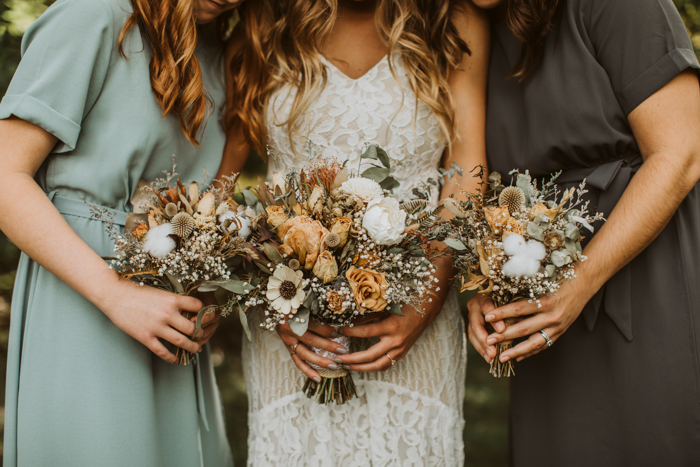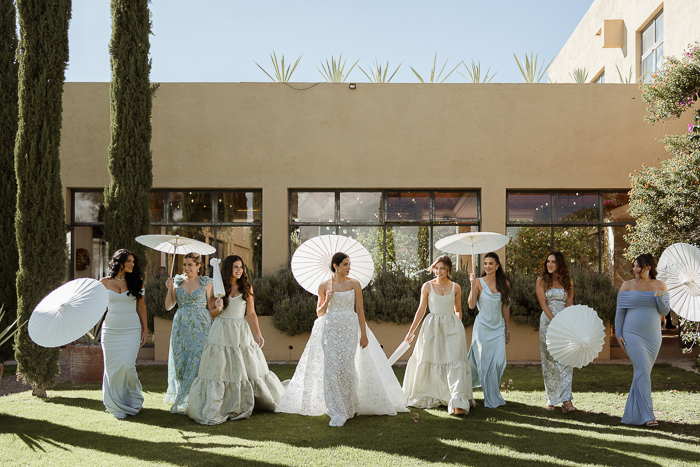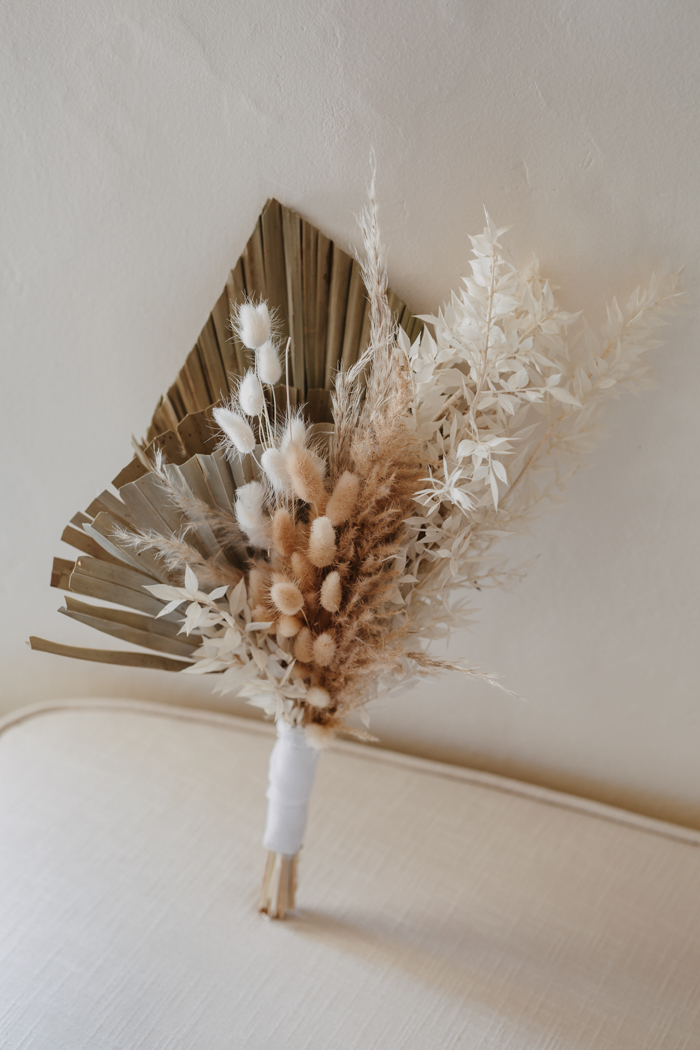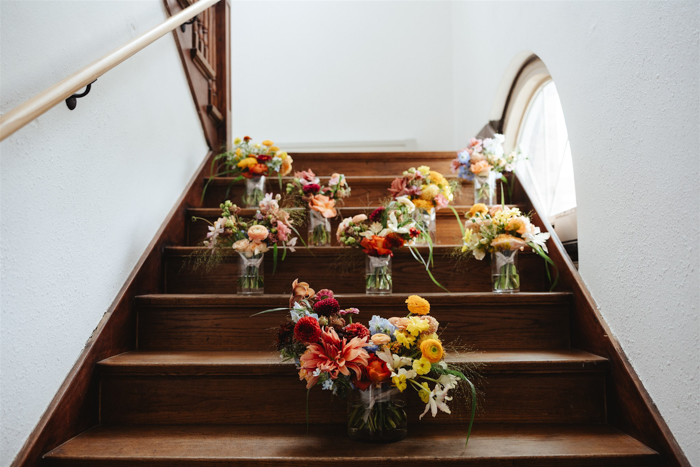Image by Na Lia Weddings
The bridal bouquet is one of the essential details of any wedding. Whether you’re decking out your ceremony and reception spaces in flowers or keeping things minimal, your bouquet will help tie your overall wedding look together together with your theme. It also acts as an emblem of affection, style, and personality.
From lush cascades of fresh florals to minimalist arrangements of wildflowers, there are such a lot of routes you possibly can go when creating your bouquet. That’s why we’re breaking down every little thing it is advisable know–including costs, stem count, easy methods to make one, easy methods to wrap it, and preservation suggestions.
What’s a Bridal Bouquet?
The bridal bouquet is a hand-held floral arrangement the bride carries as she walks down the aisle. It serves each practical and symbolic purposes. Historically, it was meant to ward off bad luck and evil spirits. In some civilizations, the flowers and herbs symbolized happiness, fidelity, and fertility. Today, it has evolved into an announcement piece that reflects the bride’s taste, the marriage theme, and, at times, the season of the celebration.
Sorts of Bridal Bouquets
Traditional Floral Bouquets
A conventional floral bouquet is what you’re probably most aware of. These bouquets are typically produced from fresh flowers like roses, peonies, lilies, or tulips and are known for his or her classic look.

Image by In Bianco e Nero
Wildflower Bouquets
Wildflowers have change into extremely popular over the past few years, so it’s no surprise that wildflower bouquets have gotten trendy. Perfect for rustic or outdoor weddings, these bouquets are less structured and infrequently include a wide range of colourful, seasonal flowers.
Really helpful Reading: 40+ Wildflower Wedding Decor Ideas For Your Big Day

Image by Meredith Washburn
Greenery and Foliage Bouquets
Your bouquet doesn’t should be made up of flowers. If you would like to keep things minimalistic, consider a bouquet manufactured from greenery like eucalyptus, monsteras, or ferns. They’re not only beautiful, but also they are budget-friendly and long-lasting.

Image by Silvia Falcomer
Non-Floral Bouquets
Some soon-to-be-wed couples go for alternatives like paper flowers, fabric flowers, and even bouquets manufactured from jewels, brooches, or feathers for a novel look. We’ve also seen parasols and singular flowers grow in popularity.

Image by EFEGE
Dried Flower Bouquets
In case you’re hosting a boho celebration, dried flowers may make the right addition to your theme–think pampas grass, dried palms, etc. These bouquets will be kept indefinitely with minimal maintenance, and so they can still are available a wide selection of colours (yes, that’s right–you possibly can have dried florals that aren’t just brown).

Image by Cinema Wedding
How Much Does a Bridal Bouquet Cost?
The value of a bridal bouquet can vary greatly depending on several aspects, including:
Size and complexity
The more intricate and enormous the bouquet, the costlier it should be. Bouquets with cascading flowers, exotic blooms, or complex arrangements will often cost more.
Flower type
Premium blooms like orchids, garden roses, or peonies are likely to be costlier, while seasonal and native flowers are generally more cost-effective. Roses and lilies are mid-range options, and wildflowers or daisies could also be more budget-friendly.
Really helpful Reading: Suggestions For Navigating Setting Up Your Wedding Floral Budget
Seasonality
Flowers which are out of season will generally be more costly because they should be imported or grown in special conditions. If there’s a flower that you simply’ve at all times envisioned being an element of your day, a fast Google search can let you know when it’s in season to show you how to prep!
Geographical location
The fee of living in your area may also impact the value of a bridal bouquet. Florists in major cities or high-cost regions typically charge greater than those in rural areas.
Average Costs by Bouquet Size:
- Small bouquets (e.g., single flower or few stems): $100–$150
- Medium bouquets (standard size for weddings): $150–$300
- Large, elaborate bouquets: $300–$500+
Junebug Tip:
If you would like to lower your expenses in your florals, there are a few things you possibly can do. As we mentioned earlier, if possible, use in-season flowers, as they’re more available and typically cheaper. We also recommend choosing filler flowers and greenery (corresponding to baby’s breath) so as to add volume without increasing the fee an excessive amount of.

Image by Let’s Frolic Together
The best way to Make Your Own Bridal Bouquet
Making your personal bridal bouquet is an excellent option to lower your expenses and add a private touch to your wedding. It could even be a chance to bond together with your wedding party. If that is something you might be considering, you’re going to want the next materials:
Materials You’ll Need:
- Fresh flowers (select a mixture of focal flowers, secondary flowers, and fillers)
- Foliage or greenery (like eucalyptus, ferns, or ivy)
- Floral tape
- Floral wire (optional, for reinforcing delicate stems)
- Ribbon or fabric for wrapping
- Scissors or pruning shears
- Floral pins (to secure the ribbon)
Step-by-Step Instructions:
- Select Your Flowers: Select a mixture of flowers based in your wedding colours, theme, and budget. You’ll be able to typically find flowers in bulk in places like Trader Joe’s, Costco, and Sam’s Club. A balanced bouquet typically includes:
- Focal Flowers: Larger blooms that catch the attention, like peonies or roses.
- Secondary Flowers: Smaller flowers like tulips or lisianthus that complement the focal blooms.
- Fillers: Greenery, baby’s breath, or smaller blooms to fill in gaps and add texture.
- Prepare the Flowers: Remove excess leaves and thorns from the stems. Trim the stems to your required length, ensuring to chop them at an angle, which allows for higher water absorption and keeps the flowers fresh for longer.
- Arrange the Flowers: Start with one or two focal flowers and step by step add secondary flowers and greenery around them. Hold the stems loosely in your hand, turning the bouquet as you add more flowers to take care of balance. Adjust the position of flowers as needed until you’re joyful with the form.
- Secure the Stems: Once satisfied with the arrangement, tightly bind the stems using floral tape. Start about 4-5 inches below the blooms and wrap downward.
- Wrap the Bouquet: Cover the floral tape together with your chosen ribbon or fabric. Secure the ribbon with floral pins, hiding them neatly throughout the fabric.
- Final Touches: Leave some extra length at the underside if you happen to desire a cascading ribbon. It’s also possible to add decorative pins, pearls, or small charms to customize your bouquet.
Junebug Tip:
While we’re perpetually advocates of DIY projects at weddings, we are able to’t recommend hiring a florist enough. They may also help bring all your flower dreams to life while also helping you remain inside budget. They know easy methods to handle your flowers beforehand and throughout the celebration (which could seem easy but does require a whole lot of work), and so they can show you how to cut costs without sacrificing your vision.

Image by Kate Merrill
How Many Stems Are Typically in a Bridal Bouquet?
The variety of stems in a bridal bouquet relies on its size, style, and the kind of flowers getting used. Listed here are some general guidelines:
Small Bouquet
A small bouquet typically comprises 10–15 stems. This is good for minimalist brides or those in search of an easy, understated look.
Medium Bouquet
A medium bouquet generally has 20–30 stems, which allows for a balanced mixture of focal flowers, secondary blooms, and fillers. That is the preferred size for bridal bouquets.
Large Bouquet
A big bouquet can contain anywhere from 40 to 60 stems or more. These are sometimes lush, full arrangements that make a dramatic statement, perfect for grand or formal weddings.
Have in mind that larger flowers–like hydrangeas or peonies–take up more room, so fewer stems could also be needed to create a full look, while smaller blooms like spray roses or daisies require more stems.

Image by Elissa Deline
The best way to Preserve Your Bridal Bouquet
After your wedding day, preserving your bouquet is usually a meaningful option to keep a long-lasting memento. There are several methods you possibly can select from, each offering a special result.
Air Drying
That is considered one of the only and hottest methods. Simply hand the bouquet the other way up in a cool, dry, and dark place, allow it to dry for about two to 4 weeks, after which spray with hairspray to preserve the form and stop crumbling.
Pressing Flowers
Pressing is an excellent option if you happen to’d prefer a flat keepsake (which will be framed). Remove the flowers from the bouquet and lay them between two sheets of parchment paper, place the parchment paper between heavy books (or use a flower press), and wait for 2-3 weeks. They’ll then be able to be framed or added to a scrapbook.
Skilled Preservation
There are firms on the market now that concentrate on bouquet preservation, using advanced techniques like freeze-drying. These professionals can preserve your bouquet in a shadow box or encased in resin, which offers a more everlasting and vibrant keepsake.
Really helpful Reading: 5 Ways to Preserve Your Wedding Bouquet
Your bridal bouquet is only the start of your wedding flowers. To be sure that you’ve gotten every little thing you would like, we’ve put together a wedding flower checklist to include florals throughout your day. And, in fact, we are able to’t recommend a florist enough. To seek out the florist that’s going to show you how to make your flower dreams a reality, take a look at our directory of florists from all over the world!

Image by Boston Mountain Photo Collective















